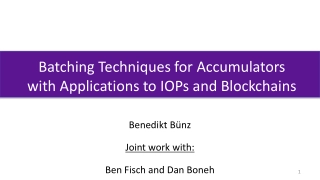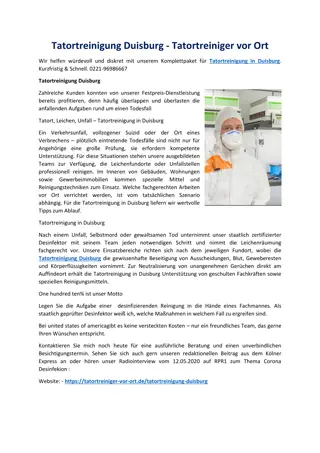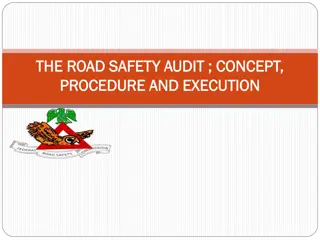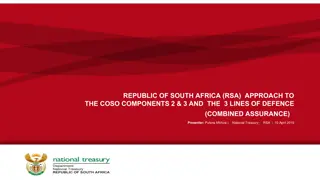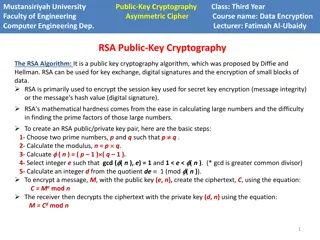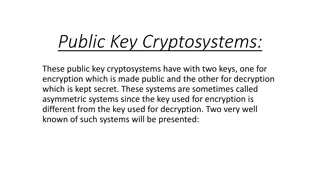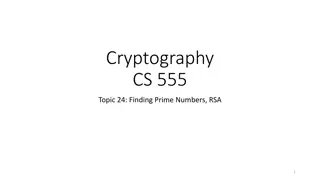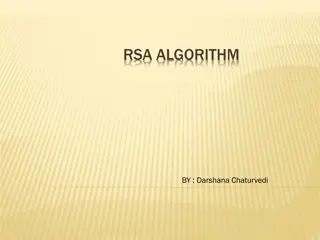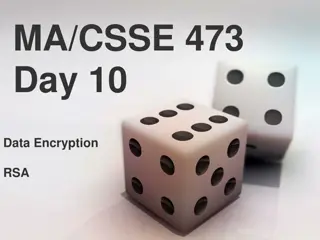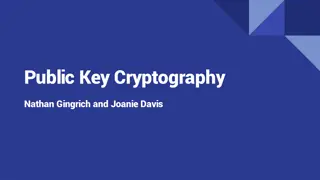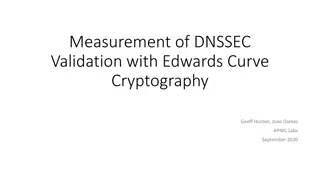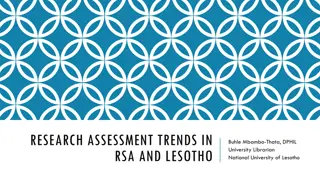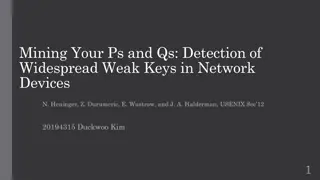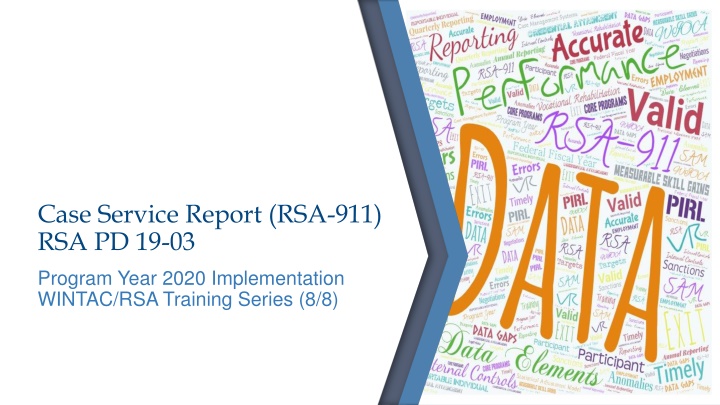
Implementation of Case Service Report (RSA-911) Training Series 2020
Explore the detailed training series on implementing the Case Service Report (RSA-911) for State Vocational Rehabilitation agencies, covering reporting requirements, tools/resources, and WIOA Annual Report insights. Get valuable guidance from expert presenters and stay informed on essential VR program updates.
Download Presentation

Please find below an Image/Link to download the presentation.
The content on the website is provided AS IS for your information and personal use only. It may not be sold, licensed, or shared on other websites without obtaining consent from the author. If you encounter any issues during the download, it is possible that the publisher has removed the file from their server.
You are allowed to download the files provided on this website for personal or commercial use, subject to the condition that they are used lawfully. All files are the property of their respective owners.
The content on the website is provided AS IS for your information and personal use only. It may not be sold, licensed, or shared on other websites without obtaining consent from the author.
E N D
Presentation Transcript
Case Service Report (RSA-911) RSA PD 19-03 Program Year 2020 Implementation WINTAC/RSA Training Series (8/8)
Training Series Objectives 1. Explain the intent of PD 19-03 reporting requirements. 2. Assist State Vocational Rehabilitation (VR) agencies in the implementation of the Case Service Report (RSA-911). 3. When possible, share examples of what needs to live outside of RSA-911 reporting, in addition to the discussed data elements (e.g., source documentation). 4. Provide considerations and expectations during each training (e.g., policies State VR agencies need to establish and implement, available tools and resources, and internal controls). 2
Presenters Andy Kerns, RSA Rachel Anderson, WINTAC 3
RSA-911 Information Used in the WIOA Annual Report (ETA-9169) (8/8 Training Series) February 2020
Todays Training 1. WIOA Annual Report (ETA-9169) Background Requirements Potential for Sanctions: Failure to Report 2. WIOA Annual Report Structure 3. RSA-911 Data Elements Used in WIOA Annual Report 4. What information on the WIOA Annual Report is not gathered from the RSA-911 5. Tools/Resources 5
WIOA Annual Report (ETA-9169) Background, Requirements, Sanctions
VR Program: WIOA Annual Reports OMB has approved the WIOA Statewide and Local Performance Report (ETA- 9169) (OMB control no: 1205-0526) through March 31, 2021. The WIOA Annual Report ICR is maintained by the U.S. Department of Labor; however, it is applicable to all core programs, including those administered by the U.S. Department of Education (ED). Section 116(d)(6)(D) of WIOA requires ED make available to the Committee on Education and Labor of the House of Representatives and to the Committee on Health, Education, Labor, and Pensions of the Senate the performance reports for the VR program and a national summary of those reports. Each time RSA publishes WIOA Annual Reports on its website, RSA transmits letters to Congress informing them that these reports are available. 7
VR Program: WIOA Annual Reports (continued) RSA published Annual Reports for the first time in PY 2017. These reports included performance data for one WIOA indicator: MSG. In Spring 2020, RSA will publish Annual Reports for PY 2018. These reports will include performance data for three WIOA indicators: MSG; Employment Rate in 2nd Quarter after Exit; and Median Earnings in 2nd Quarter after Exit. The PY 2019 Annual Reports will include performance results for all of the WIOA indicators, with exception of Effectiveness in Serving Employers as that indicator is still being piloted. 8
Negotiations and Sanctions Guidance TAC 20-02: Negotiations and Sanctions Guidance for the WIOA Core Programs On February 6, 2020, the Departments, including RSA, issued joint policy guidance that Outlines the process for negotiating levels of performance; and Provides an explanation of the two instances in which a state may be sanctioned. 9
Sanctions The term sanctions refers to the reduction of the Governor s discretionary funds by five percent of the maximum available amount in the Program Year. The Governor s reserve funds are awarded under WIOA title I. However, reduction of these funds is not just a detriment to the title I programs, it can affect statewide initiatives that may negatively impact all partners. Two types of failures can lead to Sanctions: Failure to report; and Failure to meet adjusted levels of performance. This training will only address some of the information for sanctions related to Failure to Report because it relates to the WIOA Annual Report. 10
Failure to Report: Timely and Complete The Departments consider a State as failing to submit the performance reports (WIOA Annual Reports) if the State either Does not submit the reports by 11:59 P.M. local time on October 1 (90 days after end of PY) or, Submits performance reports by the date for timely submission, but the report is incomplete. 11
WIOA Annual Report: Completeness If the WIOA Annual Report submitted by the State does not meet all of the below requirements by the deadline, the Departments will consider it incomplete. Attests all reports are complete and accurate to the best of their knowledge; Submits a WIOA Statewide Performance Report (ETA-9169) for each of the six WIOA core programs; Reports all elements of the WIOA Statewide Performance Reports as data are available according to the reporting periods of each indicator; Makes available a mechanism of electronic access to local area performance reports for title I programs; Makes available a mechanism of electronic access to Eligible Training Provider (ETP) performance reports for title I programs; and Submits at least one WIOA Statewide Performance Report that includes Effectiveness in Serving Employers performance results reflecting all six core programs. 12
What about Exceptional Circumstances? Sanctions will not be applied in cases where failure to report is due to exceptional circumstances outside the State's control as determined by the Departments. Exceptional circumstances may include, but are not limited to natural disasters; unexpected personnel transitions; and unexpected technology-related issues. Note that these are unexpected events. Sometimes a State becomes aware of events that will cause a disruption in reporting. What happens if the State knows of issues ahead of time, but cannot make the reporting deadline because of them? The State should request a reporting extension. 13
Extension Requests WIOA Annual Reports are due October 1 each year (for the PY that ended June 30); therefore, States must submit reporting extension requests not later than September 1 (or the next business day if September 1 falls on a holiday or weekend). See pages 9-10 of TAC 20-02 for more information about extension requests. Please contact RSA, as soon as possible, if the VR program becomes aware that a WIOA Annual Report extension request is necessary. 14
WIOA Annual Report Structure Including RSA-911 Data Elements
WIOA Annual Report Program Title Summary Information By Participant Characteristics By Employment Barrier Participant Level Performance Indicators Measurable Skill Gains (MSG) Report Template Effectiveness in Serving Employers (ESE) Report Template 16
Things to Know Not all of the WIOA Annual Report Template is applicable to title IV. Some title I ONLY data is collected in the report. The majority of the data is autopopulated by RSA, using the VR program s quarterly RSA-911 reports. There are five pieces of data that VR programs must complete using their RSA-2 and other agency data. Participants ONLY The WIOA Annual Report includes data for VR Program Participants, not Reportable Individuals. The RSA-911 collects additional program data that is not used in the WIOA Annual Report. 17
Program State-Level: Title IV State Not individual VR Programs (i.e., Blind and General) Title I Local Area: Not Applicable to title IV VR Programs Reporting Period Covered: Program Year (July 1 June 30) 18
Title Title IV Vocational Rehabilitation Combined VR Agencies; or Blind and General VR Agencies Together Blind and VR General Agencies MUST work together in order to submit the WIOA Annual Report. RSA autopopulates RSA-911 data from both VR Agencies. 19
Summary Information Career and Training Services Participants served Participants exited Funds expended Cost per participant served Title IV must add to the annual report. This is not autopopulated through RSA-911 Data. Percent training-related employment (Title I only) Percent enrolled in more than one core program Percent Admin Expended (Title I only) 20
Career and Training Services Data Elements (DE) RSA TAC 17-01 Attachment 7 Table D Example from chart PD 16-04 (will need adjustments for PD 19-03): Vocational Rehabilitation Service Category of Service RSA-911 DE # Participants Job Exploration Counseling (Pre-ETS) Career Service 97-102 ONLY Work Based Learning Experiences (Pre-ETS) Training Service 103-108 Occupational or Vocational Training Training Service 150-156 On-The-Job Training (OJT) Training Service 157-163 Disability Related Skills Training Training Service 184-190 VR Counseling and Guidance Career Service 226-232 Job Placement Assistance Career Service 240-246 21
Coenrollment Percent enrolled in more than one core program: Ideally, this information is collected using the RSA-911 Data Elements; however, some agencies report percentage using direct data sharing with partners. WIOA Program Involvement Data Elements: DE 54: Adult DE 55: Adult Education DE 56: Dislocated Worker DE 57: Job Corps DE 58: Vocational Rehabilitation DE 59: Wagner-Peyser Employment Service DE 60: Youth DE 61: Youth Build PD 19-03 modified definitions/instructions At time of IPE Updateable Captures WIOA Program Involvement during a PY 22
By Participant Characteristics Total Participants Served; Total Participants Exited; Performance Indicator Rates for each characteristic type: DE 9: Sex DE 8: Date of Birth DE 10-15: Race/Ethnicity 23
Participant Level Performance Indicators 1. Employment Rate 2nd Quarter After Exit 2. Employment Rate 4th Quarter After Exit 3. Median Earnings in the 2nd Quarter After Exit 4. Credential Attainment Rate 5. Measurable Skill Gains (MSG) Rate Note: See previous trainings on RSA-911 DE and reporting requirements applicable to these indicators. 24
Barriers to Employment Barriers to Employment are used in the Statistical Adjustment Model: DE 42: Individual with a Disability DE 62: Long-Term Unemployed DE 63: Exhausting TANF within 2 Years DE 64: Foster Care Youth DE 65: Homeless Individual, Homeless Children and Youths or Runaway Youth DE 66: Ex-Offender DE 67: Low Income DE 68: English Language Learner DE 69: Basic Skills Deficient/Low Levels of Literacy DE 70: Cultural Barriers DE 71: Single Parent DE 72: Displaced Homemaker DE 73: Migrant and Seasonal Farmworker PD 19-03 modified definitions/instructions At time of IPE Not Updateable Captures 13 employment barriers on Annual Report 25
Barriers to Employment Used in the SAM The Statistical Adjustment Model (SAM) is an objective regression model used to estimate levels of performance and develop the adjusted levels of performance. Before the PY, the SAM determines estimates that are used as a factor in the negotiations process. After the PY, the estimates derived from the SAM are applied to the actual economic conditions and characteristics of participants served to determine the adjustment factor. Economic conditions include differences in unemployment rates and job losses or gains in particular industries. 26
MSG WIOA Annual Report Template There are five types of MSGs collected in the Annual Report total gains are collected and included in the report and the most recent MSG earned, per participant, is used in the calculations for the MSG performance rate. DE 343: Documented achievement of at least one educational functioning level (EFL) DE 344: Documented attainment of a secondary school diploma or its recognized equivalent DE 345: Secondary or postsecondary transcript or report card DE 346: Satisfactory or better progress report towards established milestones DE 347: Successful passage of an exam Note: Details of MSGs are outlined in Training #5: Credential Attainment & Measurable Skill Gains 27
Effectiveness in Serving Employers WIOA Annual Report Template This statewide measure is submitted by one Core Program on behalf of the State generally by a title I or III core program and reported to the U.S. Department of Labor. VR Programs should be using their ESE data with their core programs in the State. This data is Submitted Annually it is not included in RSA-911 Reports. States choose 2-3 ways to measure level of performance: Retention with the same employer in the 2nd and 4th quarters after exit; Employer Penetration Rate; Repeat Business Customer Rate; and They may establish an optional State-selected measure. 28
Internal Controls Internal controls should be in place to ensure accurate reporting of RSA-911 data elements that populate the WIOA Annual Report. These internal controls should include processes for analyzing anomalies and outliers that could inevitably effect the outcome and accuracy of the Statistical Adjustment Model, thus the adjusted levels of performance. VR Agencies should have written internal controls to ensure accurate reporting of all participant level performance indicator data. VR Agencies may view their WIOA Annual Report data in RSA s data portal (rsa.ed.gov) before the data is published. 29
RSA-911 Training Series 1. Background and Implementation 2. Reporting Expenditures for VR Services 3. Pre-Employment Transition Services (Pre-ETS) 4. Supported Employment (SE) Services 5. Measurable Skill Gains (MSG) and Credential Attainment 6. Exit and Post-Exit Data Elements 7. New Data Elements Additional Need to Know Information 8. RSA-911 Information Used in the WIOA Annual Report 30
Resources: WIOA Annual Report RSA-PD 16-04 Case Service Report (RSA-911) https://www2.ed.gov/policy/speced/guid/rsa/subregulatory/pd-16-04.pdf RSA-PD 19-03 Case Service Report (RSA-911) https://www2.ed.gov/policy/speced/guid/rsa/subregulatory/pd-19-03.pdf RSA-911 Crosswalk (August 14, 2019) https://www2.ed.gov/rschstat/eval/rehab/case-service-report-rsa-911-crosswalk-of- changes.xlsx RSA TAC 17-01 https://www2.ed.gov/policy/speced/guid/rsa/subregulatory/tac-17- 01.pdf?utm_content=&utm_medium=email&utm_name=&utm_source=govdelivery&ut m_term= WIOA Performance Reporting ETA Website https://www.doleta.gov/performance/reporting/eta_default.cfm 31
Resources: WIOA Annual Report (continued) RSA s WIOA Annual Report Demo https://www.youtube.com/watch?v=mzvXTsSKhL4&t=597s WIOA Annual Report Template https://www.doleta.gov/performance/pfdocs/ETA-9169-WIOA-State-and-Performance- Report-Template.pdf WIOA Annual Reports for VR Program https://www2.ed.gov/about/offices/list/osers/rsa/wioa/vr-annual-reports/index.html WIOA Annual Reports for Titles I and III Core Programs https://www.doleta.gov/performance/results/AnnualReports/annual_report.cfm WIOA Annual Reports for Title II (AEFLA) https://www2.ed.gov/about/offices/list/ovae/pi/AdultEd/accountability-reporting.html#spr RSA-TAC-20-02 https://www2.ed.gov/policy/speced/guid/rsa/subregulatory/tac-20-02.pdf 32
Contact Andy Kerns Information Technology Specialist (202) 245-6265 RSAData@ed.gov rsa.ed.gov Rachel Anderson (435) 764-8487 randerson@ndi-inc.org www.WINTAC.org 33


